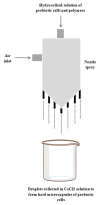Natural sources and encapsulating materials for probiotics delivery systems: Recent applications and challenges in functional food development
- PMID: 36211518
- PMCID: PMC9534265
- DOI: 10.3389/fnut.2022.971784
Natural sources and encapsulating materials for probiotics delivery systems: Recent applications and challenges in functional food development
Abstract
Probiotics are known as the live microorganisms which upon adequate administration elicit a health beneficial response inside the host by decreasing the luminal pH, eliminating the pathogenic bacteria in the gut as well as producing short chain fatty acids (SCFA). With advancements in research; probiotics have been explored as potential ingredients in foods. However, their use and applications in food industry have been limited due to restrictions of maintaining the viability of probiotic cells and targeting the successful delivery to gut. Encapsulation techniques have significant influence on increasing the viability rates of probiotic cells with the successful delivery of cells to the target site. Moreover, encapsulating techniques also prevent the live cells from harsh physiological conditions of gut. This review discusses several encapsulating techniques as well as materials derived from natural sources and nutraceutical compounds. In addition to this, this paper also comprehensively discusses the factors affecting the probiotics viability and evaluation of successful release and survival of probiotics under simulated gastric, intestinal conditions as well as bile, acid tolerant conditions. Lastly applications and challenges of using encapsulated bacteria in food industry for the development of novel functional foods have also been discussed in detail too. Future studies must include investigating the use of encapsulated bacterial formulations in in-vivo models for effective health beneficial properties as well as exploring the mechanisms behind the successful release of these formulations in gut, hence helping us to understand the encapsulation of probiotic cells in a meticulous manner.
Keywords: encapsulation; functional food; nutraceutical; probiotics; viability.
Copyright © 2022 Singh, Gupta, Chawla, Gauba, Singh, Tiwari, Upadhyay, Sharma, Chanda and Gaur.
Conflict of interest statement
The authors declare that the research was conducted in the absence of any commercial or financial relationships that could be construed as a potential conflict of interest.
Figures




Similar articles
-
Microencapsulation: a pragmatic approach towards delivery of probiotics in gut.J Microencapsul. 2021 Sep;38(6):437-458. doi: 10.1080/02652048.2021.1949062. Epub 2021 Jul 19. J Microencapsul. 2021. PMID: 34192983
-
Novel nano-encapsulated probiotic agents: Encapsulate materials, delivery, and encapsulation systems.J Control Release. 2022 Sep;349:184-205. doi: 10.1016/j.jconrel.2022.06.061. Epub 2022 Jul 8. J Control Release. 2022. PMID: 35798093 Review.
-
Delivery of Probiotics with Cellulose-Based Films and Their Food Applications.Polymers (Basel). 2024 Mar 13;16(6):794. doi: 10.3390/polym16060794. Polymers (Basel). 2024. PMID: 38543398 Free PMC article. Review.
-
Co-encapsulation of probiotics with prebiotics and their application in functional/synbiotic dairy products.Crit Rev Food Sci Nutr. 2022;62(9):2470-2494. doi: 10.1080/10408398.2020.1854169. Epub 2020 Nov 30. Crit Rev Food Sci Nutr. 2022. PMID: 33251846
-
Probiotics Encapsulated via Biological Macromolecule for Neurological Therapy and Functional Food: A Review.Probiotics Antimicrob Proteins. 2025 Jun;17(3):1754-1768. doi: 10.1007/s12602-025-10453-1. Epub 2025 Jan 16. Probiotics Antimicrob Proteins. 2025. PMID: 39821001 Review.
Cited by
-
Advances in bio-polymer coatings for probiotic microencapsulation: chitosan and beyond for enhanced stability and controlled release.Des Monomers Polym. 2024 Dec 31;28(1):1-34. doi: 10.1080/15685551.2024.2448122. eCollection 2025. Des Monomers Polym. 2024. PMID: 39777298 Free PMC article. Review.
-
Progress in Probiotic Science: Prospects of Functional Probiotic-Based Foods and Beverages.Int J Food Sci. 2025 Apr 14;2025:5567567. doi: 10.1155/ijfo/5567567. eCollection 2025. Int J Food Sci. 2025. PMID: 40259922 Free PMC article. Review.
-
Innovative Insights for Establishing a Synbiotic Relationship with Bacillus coagulans: Viability, Bioactivity, and In Vitro-Simulated Gastrointestinal Digestion.Foods. 2023 Oct 8;12(19):3692. doi: 10.3390/foods12193692. Foods. 2023. PMID: 37835345 Free PMC article.
-
Protective effect of tomato pomace extract encapsulated in combination with probiotics against indomethacin induced enterocolitis.Sci Rep. 2024 Jan 27;14(1):2275. doi: 10.1038/s41598-024-52642-y. Sci Rep. 2024. PMID: 38280919 Free PMC article.
-
Enteric Delivery of Probiotics: Challenges, Techniques, and Activity Assays.Foods. 2025 Jun 30;14(13):2318. doi: 10.3390/foods14132318. Foods. 2025. PMID: 40647075 Free PMC article. Review.
References
-
- Onwulata CI. Microencapsulation and functional bioactive foods. J Food Proces Preserv. (2013) 37:510–32. 10.1111/j.1745-4549.2012.00680.x - DOI
Publication types
LinkOut - more resources
Full Text Sources

